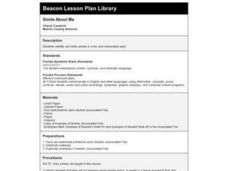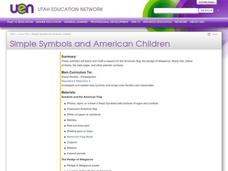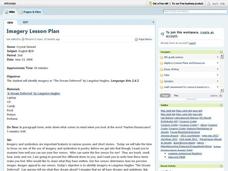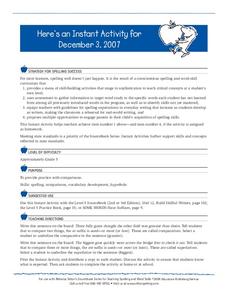Curated OER
Boogie Woogie with a B: Using Alliteration while Exploring Patriotic Tunes
Are you looking for a way to bring writing into your history activity - or history into your writing activity? This cross-curricular activity is helpful and fun, no matter what class you're teaching! Using "Boogie Woogie Bugle Boy" by...
Curated OER
Reading Comprehension 4: Level 7
Make an impression with a reading comprehension assessment based on Claude Monet. After reading a short biographical paragraph about the famous French painter, readers demonstrate their comprehension skills by drawing inferences,...
Curated OER
Pink Floyd and the Carpe Diem Theme
Students listen to Pink Floyd's "Time" in order to apply the theme of carpe diem to other works of literature and to their own life.
Curated OER
Symbolism
Young scholars engage in a activity about symbolism while reviewing the work of Edgar Allen Poe. They review the definition of symbolism and use it to list the symbols in his work. They write a journal about how the author uses many...
Curated OER
Forms of Poetry
Pupils identify distinguishing features of poetry. They identify and use literary terminology including symbol, theme, simile, and alliteration. They recognize the effects of language.
Curated OER
Figurative Language: Metaphors and Similes
Fifth graders are introduced to the figurative language using metaphors and similies. They identify the similarities and differences between the two and practice developing their own to use in their writing. They illustrate their...
Curated OER
Earth's Just Peachy!
Students are introduced to the various layers of the Earth. Using fruit, they discover each layer and discover the use of similies in describing it. They watch a video to better describe each layer of the Earth and its purpose.
Curated OER
A Collage of American Icons: Presidents and Symbols
Students use KWL charts, stores, news, books, and movies to learn about the Presidents and symbols of America. In this Presidents and symbols lesson plan, students participate in many activities that introduce them to the leaders and...
Prestwick House
"Because I could not stop for Death" -- Visualizing Meaning and Tone
Emily Dickinson's "Because I could not stop for Death" provides high schoolers with an opportunity to practice their critical thinking skills. They examine the images, diction, rhythm, and rhyme scheme the poet uses and consider how...
Curated OER
Philadelphia Museum of Art
Students study paintings and use their knowledge of story elements to analyze the art. In this art analysis lesson, students review a novel for its elements. Students study the image At the Moulin Rouge: The Dance and discuss the story...
Curated OER
Simile About Me
Learners are introduced to similes and read various examples. Then students write their own similes to describe themselves and share them with the rest of the class.
Curated OER
Three ways into the play 'Stone Cold'
Tenth graders, in groups, write pieces of a script in a particular style that they are introduced to. They also study how tension and irony work together in scripts.
Curated OER
Paco's Similes
Students engage in a activity which focuses on using conversational language and music to introduce the concept of similes, building language acquisition and helping create a positive attitude toward knowing and learning more than one...
Curated OER
Using Tone
Students are introduced to the concept of using tone in their art. They paint a narrow strip of tone of white and adding small amounts of black. Using cellophane, they put it over their strips and examine the tones of the different...
Curated OER
Simple Symbols and American Children
Students are introduced to a variety of symbols representing the United States. As a class, they identify places in which they have seen the various symbols and discuss what they mean. To end the lesson, they state the words from the...
Curated OER
Imagery Lesson Plan
Learners are introduced to the term imagery. Individually, they read "The Dream Deferred" and note examples of imagery in the poem. To end the lesson, they write their own poem making sure to use the five components of imagery.
Curated OER
Half Man, Half Limping Rabbit
Learners explore culture and change through reading "Half Main, Half Limping Rabbit" by Nina Porzucki. In this literature and cultural lesson plan, students discuss Dracula and other folk stories from Romania. Learners identify the ways...
Curated OER
Lesson Plan 8: Setting and Mood
What mood does this story evoke? How are setting and mood linked? Young novelists explore the different emotions brought about by writing, starting by journaling things that inspire their own feelings. Examine the word mood, looking into...
Curated OER
Reading Examples
Young writers read excerpts from Gary Paulsen's memoir to identify figurative and literal language that contain sensory details. They determine which selections are examples of sensory language and fi the language is used literally or...
Curated OER
Sound poems
Third graders write a class poem based on the use of sound to create effects. They investigate use of onomatopoeia and how to write in a tight structure.
Curated OER
Citizenship
Students investigate patterns of immigration in the US while comparing and contrasting the ideas of citizenship and non-citizenship. They decide how education plays a role in citizenship.
Curated OER
Orienteering - Lesson 2 - Topographical Maps
One of the most important skills in orienteering is being able to read a topographical map. Understanding the contour lines and symbols and the scale of the map will make planning your route so much better. In this lesson plan, partners...
Curated OER
Coming Home:From the Life of Langston Hughes
Third graders listen to the non-fiction book: COMING HOME: FROM THE LIFE OF LANGSTON HUGHES. They identify examples of metaphors and similies within the book and understand how this figure of speech is used in writing. They then create...
Curated OER
Comparisons
Fifth graders complete a worksheet. In this comparison lesson plan, 5th graders view sentences and identify the comparatives in them. Students complete a worksheet on comparisons.

























